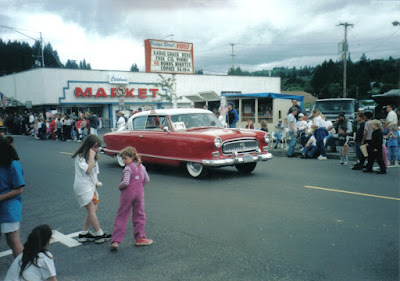Wednesday, November 14, 2018
Dodge Power Wagon
The Dodge Power Wagon was a one-ton rated truck that was introduced in 1946. It was based on the WC-series of 3/4-ton trucks and command cars that were built for the military for use in World War II from 1942 to 1945. The Dodge Power Wagon saw few changes throughout its long production run; the only one that was visible from the outside was a new pickup bed in 1951. Other changes included a 12-volt electrical system and synchromesh transmission in 1955, power steering in 1956, and power brakes in 1957, which was the peak year for Power Wagon production. The 230-cubic-inch flathead inline 6-cylinder engine was supplanted by a 251-cubic-inch version in 1961. The Power Wagon remained in production for decades with no changes to the exterior styling. Domestic sales lasted until 1968, and export production continued to 1978. This flatbed example was photographed in the 1999 Days in the Park Parade in Rainier, Oregon. There is no clear indication which model year it represents; I have it labeled as 1960 model, but I don't recall how I determined that.
Labels:
Dodge,
Rainier 1999,
Truck
Tuesday, November 13, 2018
1954 Nash Statesman Custom Country Club Hardtop Coupe
Nash introduced the Country Club hardtop coupe in 1951 for the compact Rambler model, and when the larger Statesman and Ambassador were redesigned for 1952, they also gained their own versions of the stylish body style. 1954 would be the last year for this design before a facelift in 1955. The 1954 Nash pictured here at the Heritage Days Parade in Clatskanie, Oregon, on July 4, 1999, appears to be a Statesman Custom Country Club. The Statesman was Nash's midrange model, on a 114.25-inch wheelbase with a 195.6 cubic inch inline 6-cylinder engine that produced 100 horsepower, or 110 horsepower with the Dual Powerflyte dual carburetor option. The top-of-the-line Ambassador looked almost identical, but rode on a 121.25-inch wheelbase and were powered by the 252.6 cubic inch Super Jetfire inline 6-cylinder engine that produced 130 horsepower, or 140 horsepower with the optional LeMans dual carburators and high-compression aluminum head.
Labels:
1954,
Clatskanie 1999,
Hardtop Coupe,
Nash
1969 Cadillac Hearse
This 1969 Cadillac shown here in the Heritage Days Parade in Clatskanie, Oregon, on July 4, 1999, is a former hearse that is now used by the Astoria Clowns of Astoria, Oregon. Cadillacs were restyled in 1969, abandoning the vertically stacked headlights used from 1965 to 1968 in favor of more inboard horizontal headlights. During the 1969 calendar year, Cadillac's production exceeded 250,000 cars for the first time, despite strikes affecting the 1969 production run. Among the 1969 production run were 2,550 commercial chassis. With a 156-inch wheelbase and Cadillac's 375-horsepower 472-cubic-inch V8 engine, these chassis were used by custom coachbuilders to build ambulances, hearses, and funeral flower-cars. The coachbuilders that used these chassis included the Superior Coach Corporation of Lima, Ohio, Miller-Meteor in Piqua, Ohio, and the Hess & Eisenhardt Company of Cincinnati, Ohio. I believe this example was built by Superior.
Labels:
1969,
Cadillac,
Clatskanie 1999,
Hearse
Subscribe to:
Posts (Atom)








